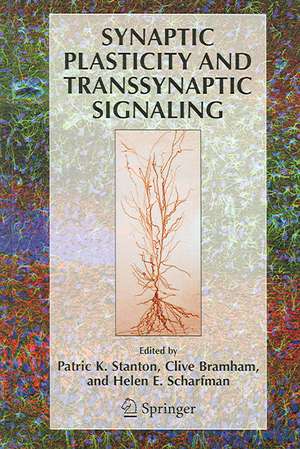Synaptic Plasticity and Transsynaptic Signaling
Editat de Patric K. Stanton, Clive Bramham, Helen E. Scharfmanen Limba Engleză Hardback – 20 iul 2005
This text focuses on one component of synaptic plasticity called transsynaptic signaling, or communication of synapses during their formation.
| Toate formatele și edițiile | Preț | Express |
|---|---|---|
| Paperback (1) | 1234.94 lei 6-8 săpt. | |
| Springer Us – 28 oct 2010 | 1234.94 lei 6-8 săpt. | |
| Hardback (1) | 1236.82 lei 6-8 săpt. | |
| Springer Us – 20 iul 2005 | 1236.82 lei 6-8 săpt. |
Preț: 1236.82 lei
Preț vechi: 1508.31 lei
-18% Nou
Puncte Express: 1855
Preț estimativ în valută:
236.70€ • 244.52$ • 196.99£
236.70€ • 244.52$ • 196.99£
Carte tipărită la comandă
Livrare economică 25 martie-08 aprilie
Preluare comenzi: 021 569.72.76
Specificații
ISBN-13: 9780387240084
ISBN-10: 038724008X
Pagini: 557
Ilustrații: XIV, 557 p. 119 illus.
Dimensiuni: 165 x 248 x 32 mm
Greutate: 0.99 kg
Ediția:2005
Editura: Springer Us
Colecția Springer
Locul publicării:New York, NY, United States
ISBN-10: 038724008X
Pagini: 557
Ilustrații: XIV, 557 p. 119 illus.
Dimensiuni: 165 x 248 x 32 mm
Greutate: 0.99 kg
Ediția:2005
Editura: Springer Us
Colecția Springer
Locul publicării:New York, NY, United States
Public țintă
ResearchDescriere
Brain functions are realized by the activity of neuronal networks composed of a huge number of neurons. The efficiency of information transfer within the networks is changeable. Even the networks themselves can change through experience. Information transfer between neurons is performed at the synapse (the site of the neurons’ contact) by release of neurotransmitters from the pre-synaptic cell and capture of neurotransmitters by the post-synaptic cell. The amount of released neurotransmitter or the efficacy of capture can change. Moreover, synapses are found to be newly formed upon activity or abandoned upon inactivity. These changes are called "synaptic plasticity".
This text focuses on one component of synaptic plasticity called transsynaptic signaling, or communication of synapses during their formation.
This text focuses on one component of synaptic plasticity called transsynaptic signaling, or communication of synapses during their formation.
Cuprins
-The three faces of norepinephrine: plasticity at the perforant path-dentate gyrus synapse -The histaminergic system in the brain: memory and synaptic plasticity -Spike timing dependent plasticity of rat hippocampal and cortical synapses and control by muscarinic transmission -Hydrogen peroxide regulates metaplasticity in the hippocampus -Presynaptic ionotropic GABA receptors: A homeostatic feedback mechanism at axon terminals of inhibitory interneurons -Activity dependent regulation of the Cl- transporting system in neurons -The truth about mossy fiber long-term potentiation -The gluzinergic synapse: who’s talking and who’s listening? -BDNF as a trigger for transsynaptic consolidation in the adult brain -On the role of neurotrophins in dendritic calcium signaling: implications for hippocampal transsynaptic plasticity -Transsynaptic dialogue between excitatory and inhibitory hippocampal synapses via endocannabinoids -Talking back: endocannabinoid retrograde signaling adjusts synaptic efficacy -Synaptic vesicle recycling as a substrate for neural plasticity -Retrograde messengers in plasticity of hippocampal excitatory synaptic transmission -Hippocampal long-term depression as a declarative memory mechanism -NMDA receptors: from protein-protein interactions to transactivation -The phases of LTP: the new complexities -CREB: a cornerstone of memory consolidation -Synaptic plasticity in the central nervous system: a role for calcium-regulated adenylyl cyclases -Rapid nuclear responses to action potentials -Coordinated pre- and postsynaptic changes involved in developmental activity-dependent synapse elimination -Recent advances in the role of integrins in developmental and adult synaptic plasticity -Consolidation: a view from the synapse -Morphological plasticity of the synapse: interactions of structure and function -Role of the spine apparatus in synaptic plasticity -Amyloid-b as a biologically active peptide in CNS
Caracteristici
The latest revision of a known classic
Has new sections covering the threat posed by the 'Superbugs', multilple drug resistances, mutations and adaptive resistance as well as vital updates included throughout
Has new sections covering the threat posed by the 'Superbugs', multilple drug resistances, mutations and adaptive resistance as well as vital updates included throughout













